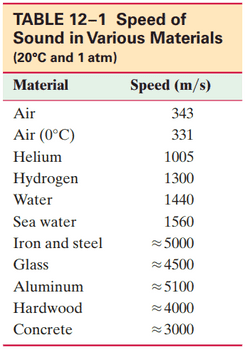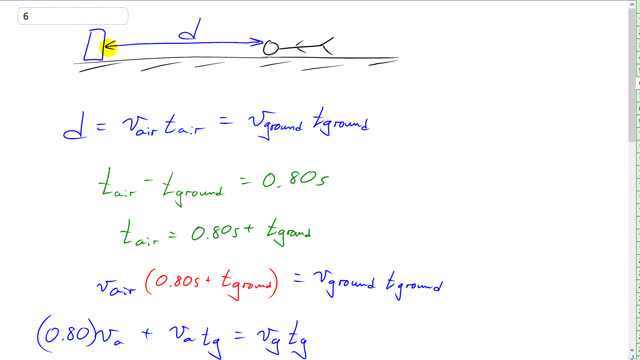
A person, with his ear to the ground, sees a huge stone strike the concrete pavement. A moment later two sounds are heard from the impact: one travels in the air and the other in the concrete, and they are 0.80 s apart. How far away did the impact occur? See Table 12–1.


In order to watch this solution you need to have a subscription.
This is Giancoli Answers with Mr. Dychko. This person has their ear to the ground and there's a stone that hits the concrete pavement which is the ground, at some distance, d, away, and they hear the sound of the impact twice, once. The first time is due to the sound traveling through the concrete that goes faster about 3,000 meters per second. And then the second time they hear it is when the sound reaches their ear through the air. And it's traveling at only 343 meters per second through the air. And we don't know the time for either of these sound travels but we do know the difference between them is 0.8 seconds. So, the time that it travels through the air is 0.8 seconds more than the time it takes to travel through the ground so, we have this distance is the speed times time and it's the same distance whether the sound is going through the air or the ground. So, we have the distances speed of the sound through air times the time it takes to go through the air. And that also equals the speed of sound through the ground multiplied by the time it takes to go through the ground. And then we can substitute from here knowing that t air is 0.8 more than t ground and substitute for t air is 0.8 plus t ground times by v air equals v ground t ground. And to save myself some writing I changed the word air into the letter a and the word ground with the letter g. So, multiply through by va and you get va times 0.8. And then va times tg and that equals vg times tg and our job is to solve for tg. And then after we get an expression for tg we say the distance is speed to the ground times time to the ground and then we'll substitute for tg here. So, now we have this term of the right side which makes it a minus va tg. And then switch the sides around so we have the tg unknown on the left. Factor out the tg. It gets multiplied by vg minus va, all equals 0.8 va. Then divide both sides by this bracket, and you get time to the ground equals 0.8 va divided by vg minus va. And then the distance is vg tg and then substitute in the 0.8 v air divided by v ground minus v air. And then we get 310 meters. By looking at table 12-1 on page 329, you can see that the speed of sound through concrete is about 3,000 meters per second, and times that by 0.8 times the speed of sound through air, 343 meters per second divided by the difference between those speeds and you get 310 meters.